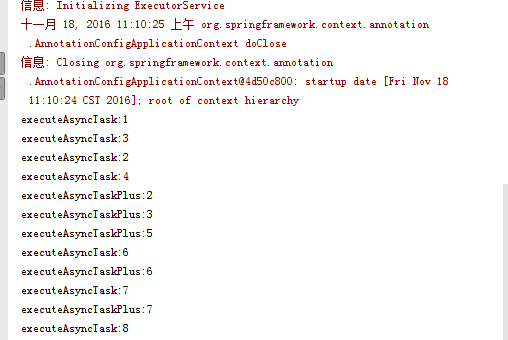【Spring】Spring高级话题-多线程-TaskExecutor
2018-01-23 16:46
603 查看
分析
在Spring中,通过任务执行器,也就是TaskExecutor来实现多线程和并发编程。使用ThreadPoolTaskExecutor可实现一个基于线程池的TaskExecutor。
而实际开发中任务一般是非阻碍的,也就是非异步的,所以我们要在配置类中通过@EnableAsync开启对异步任务的支持,并通过在实际执行的Bean的方法中使用@Async注解来声明其是一个异步任务。
进行本示例的演示,需要先配置好Maven和Spring哦、
见:
【Spring】基于IntelliJ IDEA搭建Maven
示例
配置类
首先看一下配置类。 现在全部使用Java配置哦,不用xml了。
package cn.hncu.p3.p2_TaskExecutor;
import org.springframework.aop.interceptor.AsyncUncaughtExceptionHandler;
import org.springframework.context.annotation.ComponentScan;
import org.springframework.context.annotation.Configuration;
import org.springframework.scheduling.annotation.AsyncConfigurer;
import org.springframework.scheduling.annotation.EnableAsync;
import org.springframework.scheduling.concurrent.ThreadPoolTaskExecutor;
import java.util.concurrent.Executor;
/**
* Created with IntelliJ IDEA.
* User: 陈浩翔.
* Date: 2016/11/18.
* Time: 上午 9:35.
* Explain:配置类
*/
@Configuration
@ComponentScan("cn.hncu.p3.p2_TaskExecutor")
@EnableAsync //利用@EnableAsync注解开启异步任务支持
public class TaskExecutorConfig implements AsyncConfigurer{
//配置类实现AsyncConfigurer接口并重写getAsyncExcutor方法,并返回一个ThreadPoolTaskExevutor
//这样我们就获得了一个基于线程池的TaskExecutor
@Override
public Executor getAsyncExecutor() {
ThreadPoolTaskExecutor taskExecutor = new ThreadPoolTaskExecutor();
taskExecutor.setCorePoolSize(5);//线程池维护线程的最少数量
taskExecutor.setMaxPoolSize(10);//线程池维护线程的最大数量
taskExecutor.setQueueCapacity(25);//线程池所使用的缓冲队列
taskExecutor.initialize();
return taskExecutor;
}
@Override
public AsyncUncaughtExceptionHandler getAsyncUncaughtExceptionHandler() {
return null;
}
}12
3
4
5
6
7
8
9
10
11
12
13
14
15
16
17
18
19
20
21
22
23
24
25
26
27
28
29
30
31
32
33
34
35
36
37
38
39
40
任务执行类
也就是实际运行的,需要异步执行的类package cn.hncu.p3.p2_TaskExecutor;
import org.springframework.scheduling.annotation.Async;
import org.springframework.stereotype.Service;
/**
* Created with IntelliJ IDEA.
* User: 陈浩翔.
* Date: 2016/11/18.
* Time: 上午 10:57.
* Explain:任务执行类
*/
@Service
public class AsyncTaskService {
@Async
//通过@Async注解表明该方法是个异步方法,如果注解在类级别,则表明该类所有的方法都是异步方法。
// 而这里的方法自动被注入使用ThreadPoolTaskExecutor作为TaskExecutor
public void executeAsyncTask(Integer i){
System.out.println("executeAsyncTask:"+i);
}
@Async
public void executeAsyncTaskPlus(Integer i){
System.out.println("executeAsyncTaskPlus:"+i);
}
}12
3
4
5
6
7
8
9
10
11
12
13
14
15
16
17
18
19
20
21
22
23
24
25
26
27
28
29
运行类
为了测试而写的运行调用方法的类package cn.hncu.p3.p2_TaskExecutor;
import org.springframework.context.annotation.AnnotationConfigApplicationContext;
/**
* Created with IntelliJ IDEA.
* User: 陈浩翔.
* Date: 2016/11/18.
* Time: 上午 11:04.
* Explain:运行类
*/
public class Main {
public static void main(String[] args) {
AnnotationConfigA
aac1
pplicationContext context = new AnnotationConfigApplicationContext(TaskExecutorConfig.class);
AsyncTaskService asyncTaskService = context.getBean(AsyncTaskService.class);
for(int i=0;i<10;i++){
asyncTaskService.executeAsyncTaskPlus(i);
asyncTaskService.executeAsyncTask(i+1);
}
context.close();
}
}12
3
4
5
6
7
8
9
10
11
12
13
14
15
16
17
18
19
20
21
22
23
24
25
26
运行结果

运行结果长了一点,所以只传了这么一点。
但是已经能够看出了,假如是原来那样的,是同步执行,那么肯定偶数行的输出比前一个奇数行的输出是大1的。
结果不是那样,它们是异步进行的,在这里由一个主线程(main线程)。
for循环里面,每运行一行调用方法的,就会开一个线程。
也就是说,你每次的运行结果可能会不一样!
所以,如果你的运行结果和我的不一样,不要慌哦。
相关文章推荐
- 【Spring】Spring高级话题-多线程-TaskExecutor
- 使用Spring ThreadPoolTaskExecutor实现多线程任务
- 使用Spring ThreadPoolTaskExecutor实现多线程任务
- 三-Spring高级话题(1)-多线程、计划任务-【JavaEE开发的颠覆者】
- spring boot-高级话题之 多线程、@EnableScheduling开启计划任务的支持(2)
- Spring高级话题_多线程
- 10-SpringBoot——Spring 高级话题-多线程
- spring ThreadPoolTaskExecutor的线程池类实现多线程
- SpringBoot4-spring高级话题-spring aware,多线程,计划任务,条件注解@Conditional
- Spring4.x高级话题(二):多线程
- Spring TaskExecutor
- 使用Spring的taskExecutor实现线程池
- spring boot之高级话题--@Enable*注解的工作原理(5)
- Spring中的线程池ThreadPoolTaskExecutor
- 【Spring】Spring高级话题-组合注解与元注解
- spring boot--高级话题之Aware(1)
- Spring线程池ThreadPoolTaskExecutor配置及详情
- SpringTaskExecutor介绍
- Spring Task Schedule 及多线程
- Spring高级话题-@Enable***注解的工作原理
